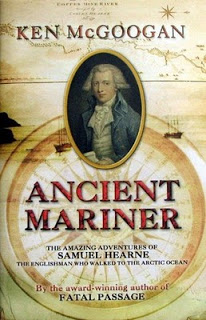Northwest Passage voyage dazzles even old hands
This past autumn, we sailed Out of the Northwest Passage with Adventure Canada. Our Hero wrote the logbook (see pic), a full-color version of which goes automatically to passengers. Next August, we’ll sail the other way: Into the Passage. What’s it like? Coming your way: a few excerpts.
This voyage left even old hands awestruck
and reeling. Sixteen days in the Northwest Passage. We got every kind of
weather, from dead calm in one of the most beautiful fjords in the world to
reeling and rocking along an infamous stretch of Greenland coast. We sailed in
the Ocean Endeavour, a ship new to Adventure Canada, easily the biggest and best
yet. Would you believe eighteen zodiacs? A functioning hot tub? Yoga sessions and
massage therapy?
We had a captain, Peter Gluscke, who loves
expedition travel and would happily probe a shallow bay, hug a cliff face, or
sail between massive icebergs. Above all, perhaps, we had the farewell voyage
of Stefan Kindberg, a veteran expedition leader who has played a key role in
shaping Adventure Canada. Towards the end of this sailing, at a special recap,
one staff member after another paid tribute to Kindberg — a process that
culminated in a heartfelt thank you from Matthew James (M.J.) Swan, who hailed the
retiring Swedish-American as a role model.
During the Variety Show, Kindberg introduced
his favorite poem, claiming straight-faced that he had translated it from the
original Sami language into Swedish, and from there into English. He then
launched into an unforgettable poetry reading: “You can dance, you can jive, having
the time of your life. / See that girl, watch that scene, digging the Dancing
Queen.” On he went, in his Swedish accented English, reciting the lyrics of
Abba’s most famous song.
The 169 passengers included seven or
eight medical doctors and any number of PhDs. These were educated professionals
keenly interested in exploration history and, while they embraced the voyage’s
many dimensions, they were not about to put the explorers behind them. As it
happened, we had history covered: besides myself and archaelogist Latonia
Hartery, we had staffers Natalie Swain, Aaron Spitzer, and James Raffan well
qualified to talk history.
Margaret Atwood scored by tracing her
extraordinary writing career in a self-effacing presentation that featured an
entrancing song. Another popular speaker was American astronaut Charlie Duke,
who travelled with his wife, Dorothy, and talked about visiting the moon. And Marc
St. Onge, Canada’s most charismatic geologist, enticed dozens of passengers
into his world of tectonic plates and ancient rocks. Lois Suluk-Locke
taught throat-singing, and with Susie Evyagotailak, introduced us Inuit
languages. And that was not the half of it . . . .
DAY ONE
Saturday, Sept. 5
Late in the afternoon, having settled
into the Ocean Endeavour at Kugluktuk (Coppermine), we started sailing east. We
were following the route John Franklin took during his “overland” expedition of
1819-1822 – an outing that ended in disaster.
Our own voyage began without a hitch.
Early in the morning, we boarded two charter flights in Leduc, Alberta,
not far from the Edmonton International Airport. One plane refueled in Yellowknife, while the
other flew direct.
On arrival, both groups boarded buses
and travelled the short distance to the floating dock that provides entrance
into Coronation Gulf. It was near here that, in 1772, Samuel Hearne of the
Hudson’s Bay Company became the first European explorer to reach the Arctic coast
of North America. Hearne had travelled here over a period of several months
with a group of Chipewyan Dene led by the legendary Matonabbee. One of our
passengers, Allan Derbyshire, had retraced part of that route, paddling down
the Coppermine River to join us.
Now, on the Ocean Endeavour, we settled
into our cabins: 169 passengers and 38 staff members, among them
ornithologists, mammal experts, Inuit culturalists, historians. Early in the
afternoon, a few Inuit based in Kugluktuk boarded the ship, welcomed us to
Nunavut, and then entertained with a presentation that constituted a snapshot
of one of the fastest changing cultures in the world.
As for Franklin, having made his way
to the mouth of the Coppermine, near the contemporary settlement of 1,500
people, he and his men paddled east, mapping the coast. His native guides
warned repeatedly that the expedition would soon run out of food, that no Inuit
hunters would be rousted in this region, and that all potential game had gone
south for the winter.
Obstinately, Franklin persisted, mapping the
coast as far as a hill on the Kent Peninsula he called Turnagain Point. The
guides proved correct. Running short of food while retracing his path, Franklin
made a desperate, overland dash inland for Fort Enterprise, where he had
started. Eleven of his twenty men died, most from starvation. Franklin was
rescued by some Yellowknife Dene. Back in England, after publishing a journal
about the expedition, Franklin was lionized as “the man who ate his boots.”


An absolutely fascinating account Ken, so sorry we never had a chance to travel together.